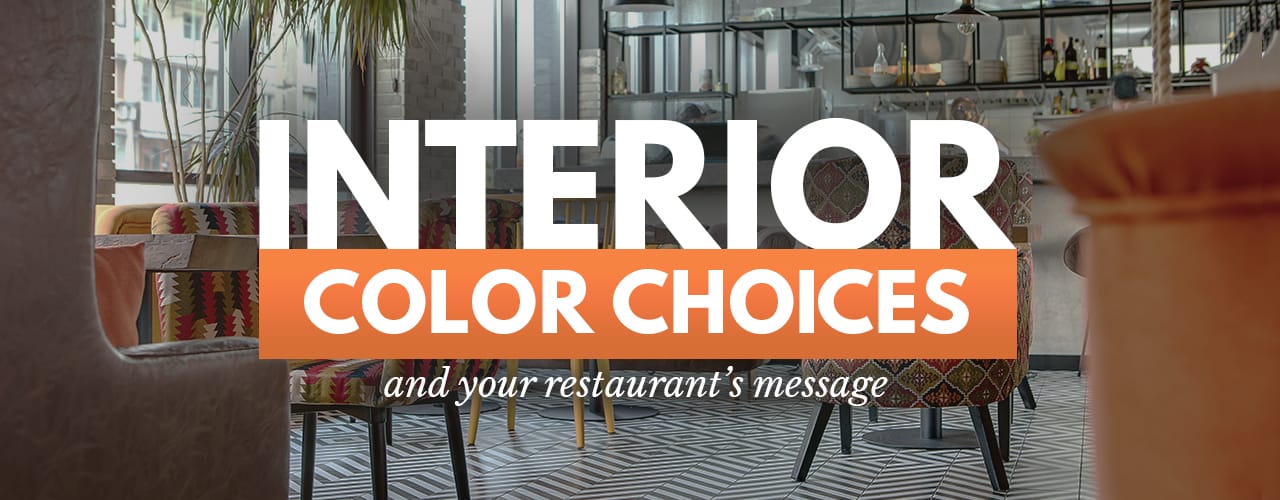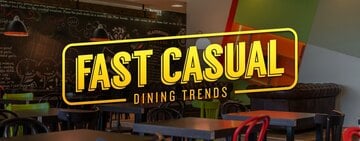How Restaurant Color Schemes Affect Your Customers
Last updated on Sep 11, 2023Richard TraylorThe colors you use to decorate your foodservice establishment can influence how long customers spend in your operation and how they feel. Colors can make your customers happy, boost their appetite, increase table turnover, and make your dining space seem more spacious. However, they can also negatively affect your customers, so it's good to understand how your interior color choices affect your restaurant's message. We've compiled a list of the best color palettes for different restaurant types and how to utilize color psychology when designing your dining room.
5 Color Scheme Ideas
Now that you know how colors will affect your customers, you need to understand which colors go together and how to make a pleasing color scheme. For readers that don't have much interior decorating experience, we created a list of some versatile and popular color schemes to give you an idea of what colors go together. Here are five interior color scheme ideas:
1. Light Color Scheme
Colors: Ivory, beige, white, pale yellow, light gray
A light or neutral color scheme is often used to make a smaller room look bigger than it is. Additionally, light colors evoke a leisurely and relaxing atmosphere and are not visually distracting, which makes them an excellent choice for traditional sit-down restaurants, bistros, and upscale eateries. Due to the relaxed and comfortable feeling this color scheme evokes, it's not ideal for restaurants that want a high turnover rate.

2. Dark Color Scheme
Colors: Crimson, brown, purple, navy, dark green
A dark color scheme is excellent for creating intimate and romantic settings and is perfect for some bars, trendy restaurants, and taverns. However, using too many dark colors or too dark of a shade can make your space feel cramped and claustrophobic. Try balancing out a dark wall color by adding contrast like bright art, greenery, florals, and plenty of ambient lighting to make it cozy.

3. Warm Color Scheme
Colors: Yellow, terracotta, orange, red, gold
Warm colors are bright, exciting, and visually stimulating for guests. Because these colors are so bright, they can become overwhelming after a long period. Warm colors help increase your turnover rate and are ideal for high-volume establishments like fast-casual eateries, buffets, or fast food restaurants.

4. Earthy Color Scheme
Colors: Brown, olive green, beige, umber, dark orange
An earthy color palette features colors found organically in nature, including shades of brown, green, and some neutral colors. An earthy color scheme is ideal for relaxed and welcoming environments like cafes, bars, and trendy restaurants. Additionally, color schemes with predominately green and brown colors are excellent choices for menus focused on organic and natural foods.

5. Pastel Color Scheme
Colors: Sky blue, pink, light yellow, lavender, pale green
The pastel color scheme is soft and delicate, making it great for sweet shops, bakeries, and cafes. Because these colors are very light, they have an almost neutral tone that can fit in with most types of decor. This color scheme can create a calm, sophisticated aesthetic with the right balance. To avoid designing an atmosphere that reads too youthful, contrast with neutral shades such as white and light gray or dark wood tones.

The Psychology of Colors
Because various colors can affect your guests in different ways, they are powerful tools for shaping how your customers interact in your restaurant and with your menu. It also means that you can't just choose colors for your walls and decorations arbitrarily, and you'll have to use thought when choosing your restaurant's color scheme. Here is a brief summary of how common colors affect your customers and which types of establishments might utilize them:
Red
Red increases your guests' heart rates and can make them hungry. It can also make your guests eat quickly and leave, which is useful for increasing your table turnover rate.
Establishments that should use the color red:
- Fast food restaurants
- Fast casual restaurants
- Establishments that want a high table turnover
Orange
Orange makes people feel happy and cheerful. It's also excellent for establishments that serve desserts or unhealthy food because it makes people content and less likely to feel guilty for eating poorly.
Establishments that should use the color orange:
- Fast food restaurants
- Ice cream shops
- Casual eateries
Yellow
Some shades of bright yellow have a similar impact as orange, making people happy and content. Generally, yellow is very vibrant and exciting, so it's not an ideal choice for relaxed environments.
Establishments that should use yellow:
- Fast casual restaurants
- Ethnic eateries
- Bistros
- Cafes
Green
Earthy tones like green are very relaxing and comforting. Green is found commonly in nature, making it an excellent choice for establishments that serve healthy and natural foods.
Establishments that should use the color green:
- Health food stores
- Salad bars
- Vegetarian and vegan restaurants
Brown
Brown is an earthy color that helps guests relax and feel comfortable. It can also give customers a sense of support and stability, and it can even convince guests to come back as repeat customers.
Establishments that should use brown in their decor:
- Coffee shops
- Bistros
- Contemporary restaurants
- Bars
Blue
Blue is a color that most restaurants should avoid. It's not commonly found naturally in food, and it can cause your customers to lose their appetites. Additionally, if you have bright blue walls, the shade of blue can reflect onto your food and make it look less appetizing. Blue reduces customers' appetites, but it makes them thirsty.
Establishments that should use blue for their interior design:
- Coffee shops
- Bars
- Cafes
- Nightclubs
- Seaside restaurants
White
White gives your space a relaxed and leisurely feel. The color evokes a sense of cleanness and freshness and can make a small space seem larger. However, too much white can make your dining area look sterile. Avoid this by using creamy, off-white colors and contrasting accent decor.
Establishments that should incorporate white into their decor:
- Small restaurants and bistros
- Upscale eateries
- Banquet halls
- Wedding venues
Black
Since it's not a common food color and can be an appetite suppressant, use black sparingly and strategically. It can make the other colors in your restaurant pop and look more vibrant, but too much black can make your space look cramped and dark. Use furniture, such as metal pendant lights or dining chairs, to add black accents to neutral color palettes for increased visual impact.
Establishments that should use black accents in their interior:
- Nightclubs
- Bars
- Contemporary restaurants
Menu Color Schemes

Your restaurant's interior isn't the only place you need to be conscious about your color choice - the colors on your menu can also affect your customers. When creating a menu for your restaurant, be aware of which colors you're using and how they influence your customers' appetites and choices. Avoid unnatural colors like blue and purple and instead choose bright and vibrant colors like red and orange, depending on your restaurant's concept and style.
Make sure the colors you choose for your menu complement each other and are cohesive with the colors in your dining space. For example, you wouldn't want to use a lot of bright colors on your menu if your interior uses a lot of earthy colors like brown and dark green.
Choosing a restaurant color scheme is vital to your establishment's brand and perception. The choice of paint and decor colors plays a significant role in setting the ambiance of your dining area. It can create a cozy, romantic, or invigorating atmosphere, depending on the experience you want to provide to your customers.



